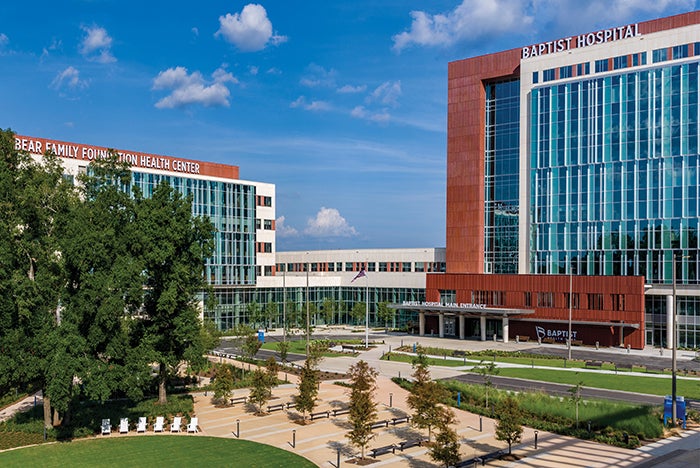Baptist Health opens community-centered campus

Design of the new Baptist Hospital incorporates many lessons learned from the COVID-19 pandemic.
Image courtesy of Baptist Health Care
After more than 70 years of service, Baptist Health Care (BHC) has replaced its original Baptist Hospital in Pensacola, Fla., with a new 10-story patient-centered facility. The hospital is the centerpiece of a new $650 million, 57-acre campus designed to enhance BHC’s community connection and deliver advanced patient care.
“When Baptist Hospital opened in 1951, it was considered a beacon of modern health care,” says Mark Faulkner, BHC’s president and CEO. “The new Baptist Hospital campus is transformational, offering the latest features and design for today and the ability to adapt for the future. We have raised the bar for health care experiences, safety, quality and efficiency.”
Architecture firm Gresham Smith designed the new 268-bed Baptist Hospital to ensure more efficient patient care. Nursing support and medical equipment storage spaces are distributed throughout care units to facilitate communication and speed response time. Services including imaging, therapy and pharmacy are located within patient care areas to streamline care delivery. Standardized treatment spaces ensure a consistent experience for patients and staff.
Several areas within the hospital feature added flexibility based on lessons learned during the COVID-19 pandemic. Half of the emergency room can be converted into negative-pressure rooms, and 15 patient rooms can be converted into COVID-19 suites. Isolation rooms on each inpatient floor include enhanced headwalls with additional medical gas and nurse call capabilities. If needed, a second bed can be added to these rooms to double isolation capacity.
Supporting this thoughtful layout and warm finishes is a structure built to remain functional during the power and water service interruptions that might accompany a Category 5 hurricane or 1,000-year storm flooding event. Two separate electrical substations provide power redundancy, while a backup water connection enables supply from a tanker in the event of service interruption. Rainwater reuse and underground wells deliver gray water to irrigation systems and cooling towers in a move that is both sustainable and reduces the campus demand for potable water.




